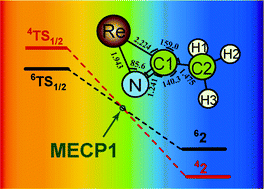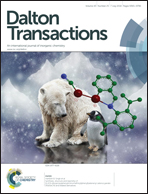Investigation on spin-flip reaction of Re + CH3CN by relativistic density functional theory
Abstract
To explore the integrated reaction mechanisms for Re atom with acetonitrile theoretically, density functional theory with zero-order regular approximation (ZORA) relativistic corrections has been employed at the BP86/TZ2P level. There have been three adiabatic potential energy surfaces in the study along sextet, quartet and doublet spin states. However, the detailed minimum energy reaction pathway altogether contains six stationary states (1) to (6), five transition states (TS), and two intersystem crossings with spin inversion (marked by ⇒): 6Re + CH3CN → η1-ReNCCH3 (61) → 6TS1/2 ⇒ η2-Re(NC)CH3 (42) → 4TS2/3 → η3-HRe(NCCH2) (43) → 4TS3/4 → CH3–ReNC (44) → 4TS4/5 → CH2![[double bond, length as m-dash]](https://www.rsc.org/images/entities/char_e001.gif) Re(H)NC (45) ⇒ 2TS5/6 → CH
Re(H)NC (45) ⇒ 2TS5/6 → CH![[triple bond, length as m-dash]](https://www.rsc.org/images/entities/char_e002.gif) Re(H)2NC (26). Thereinto, the lowest energy crossing points (LECP) have been determined by the DFT fractional-occupation-number (FON) approach. The first spin inversion has transferred the potential energy surfaces from high-spin sextet to the quartet intermediate (42) with the subsequent C–C bond breakage. The second one from the quartet to the low-spin doublet state accompanies the C–H activation, decreasing the transition barrier by 157 kJ mol−1. The overall reaction could be exothermic by about 210 kJ mol−1. Harmonic vibration frequencies and NBO, WBO analysis are also applied to verified the experimental observed information.
Re(H)2NC (26). Thereinto, the lowest energy crossing points (LECP) have been determined by the DFT fractional-occupation-number (FON) approach. The first spin inversion has transferred the potential energy surfaces from high-spin sextet to the quartet intermediate (42) with the subsequent C–C bond breakage. The second one from the quartet to the low-spin doublet state accompanies the C–H activation, decreasing the transition barrier by 157 kJ mol−1. The overall reaction could be exothermic by about 210 kJ mol−1. Harmonic vibration frequencies and NBO, WBO analysis are also applied to verified the experimental observed information.


 Please wait while we load your content...
Please wait while we load your content...